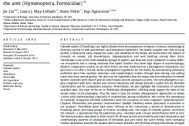Content
Cobweb spiders (Theridiidae) are highly diverse from the perspective of species richness, morphological diversity, variety of web architecture, and behavioral repertoires. The family includes over 50% of social spiders, a behavioral rarity among the order, and members of the family are furthermore the subject of research on venom, silk biomechanics, kleptoparasitism and web building, among other traits. Theridiidae is one of the most abundant groups of spiders, and thus key insect predators in many different ecosystems and is among relatively few spider families that show high degree of myrmecophagy. Modern comparative studies on all these fronts are best buttressed on a phylogenetic foundation. Our goal here is to offer a revised, dated, phylogenetic hypothesis for the family by summarizing previously published data from multiple molecular and morphological studies through data-mining, and adding novel data from several genera. We also test the hypothesis that the origin and diversification of cobweb spiders coincides with that of ants on which many species specialize as prey. The new phylogeny is largely congruent with prior studies and current taxonomy and should provide a useful tool for theridiid classification and for comparative analyses. Nevertheless, we also highlight the limitations of currently available data he state of the art in Theridiidae phylogenetics—offering weak support for most of the deeper nodes in the phylogeny. Thus the need is clear for modern phylogenomic approaches to obtain a more solid understanding, especially of relationships among subfamilies. We recover the monophyly of currently recognized theridiid subfamilies with the exception of some enigmatic ‘pholcommatines’ (Styposis, Phoroncidia) and putative ‘hadrotarsines’ (Audifia, Tekellina) whose placement is uncertain in our analyses. Theridiidae dates back some 100 mya to the Cretaceous, a period of diversification in flowering plants and many groups of insects, including ants. The origin of cobweb spiders, and hence the cobweb—a speciallized trap for pedestrian prey— oincides with a major diversification shift in ants. The family becomes abundant in fossil record 50–40 mya as ants also diversify and reach dominance and contemporary patterns of abundances of theridiids and ants show the same trends, with increasing relative abundance towards the equator and at lower altitudes. We find that among orbiculariae, lineages that specialize on ant prey are non-randomly clustered within Theridiidae. Given these findings we hypothesize that the origin of the gumfoot web was a stepping stone that facilitated the capture of ants and resulted in specialized myrmecophagy in a number of ‘basal’ theridiids. We also document a subsequent loss in myrmecophagy, and associated increase in speciation rates, as ‘recent’ theridiid groups evolve diverse web forms and many return to the capture of aerial prey.



